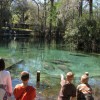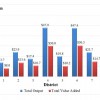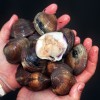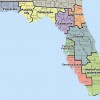 This study examined the economic contributions, consumer surplus, and ecosystem services provided by recreational use of fifteen major springs sites in north central Florida. The estimated annual economic contributions of springs-related recreational spending in north-central Florida for FY 2012/13 are summarized. Among the findings, there was $84.2 million in total visitor spending for springs recreation, and 1,160 full- and part-time jobs. This 4-page fact sheet was written by Tatiana Borisova, Alan W. Hodges, and Thomas J. Stevens, and published by the UF Department of Food and Resource Economics, April 2015.
This study examined the economic contributions, consumer surplus, and ecosystem services provided by recreational use of fifteen major springs sites in north central Florida. The estimated annual economic contributions of springs-related recreational spending in north-central Florida for FY 2012/13 are summarized. Among the findings, there was $84.2 million in total visitor spending for springs recreation, and 1,160 full- and part-time jobs. This 4-page fact sheet was written by Tatiana Borisova, Alan W. Hodges, and Thomas J. Stevens, and published by the UF Department of Food and Resource Economics, April 2015.
http://edis.ifas.ufl.edu/fe958
Tag: Alan W. Hodges
Economic Impacts of Highway Beautification in Florida
 The Florida Department of Transportation is allocated money every year for highway landscaping projects. They make driving more pleasant and are better for the environment, but do they attract private investment and contribute to the economy? This study, commissioned by the FDOT, finds that the average annual economic impacts of highway beautification expenditures in Florida during 2008–2013 amounted to $46 million in output impacts and $28 million in value-added impacts. This 7-page fact sheet was written by Hayk Khachatryan, Alan W. Hodges, Mohammad Rahmani, and Thomas J. Stevens, and published by the UF Department of Food and Resource Economics, December 2014.
The Florida Department of Transportation is allocated money every year for highway landscaping projects. They make driving more pleasant and are better for the environment, but do they attract private investment and contribute to the economy? This study, commissioned by the FDOT, finds that the average annual economic impacts of highway beautification expenditures in Florida during 2008–2013 amounted to $46 million in output impacts and $28 million in value-added impacts. This 7-page fact sheet was written by Hayk Khachatryan, Alan W. Hodges, Mohammad Rahmani, and Thomas J. Stevens, and published by the UF Department of Food and Resource Economics, December 2014.
http://edis.ifas.ufl.edu/fe963
Economic Value of the Services Provided by Florida Springs and Other Water Bodies: A Summary of Existing Studies
 Florida residents and visitors place a high value on aquatic natural resources. This 8-page fact sheet reviews nine studies that demonstrate that Florida’s springs have a very large economic value, both for recreation and resource conservation. In these studies, economists measure the value of ecosystem services in dollar terms to assist management decisions concerning natural resources. Willingness to pay studies show that people who benefit from Florida springs place a high value on them. Economic contribution studies show that Florida springs play a significant role in local and state economic health and job creation. Written by Sara Wynn, Tatiana Borisova, and Alan Hodges, and published by the UF Department of Food and Resource Economics, November 2014. (UF/IFAS Photo by Tyler Jones.)
Florida residents and visitors place a high value on aquatic natural resources. This 8-page fact sheet reviews nine studies that demonstrate that Florida’s springs have a very large economic value, both for recreation and resource conservation. In these studies, economists measure the value of ecosystem services in dollar terms to assist management decisions concerning natural resources. Willingness to pay studies show that people who benefit from Florida springs place a high value on them. Economic contribution studies show that Florida springs play a significant role in local and state economic health and job creation. Written by Sara Wynn, Tatiana Borisova, and Alan Hodges, and published by the UF Department of Food and Resource Economics, November 2014. (UF/IFAS Photo by Tyler Jones.)
http://edis.ifas.ufl.edu/fe959
Tracking the Economic Benefits Generated by the Hard Clam Aquaculture Industry in Florida
 The hard clam industry is a true success story for commercial aquaculture in Florida. From a cottage industry borne of reductions in commercial wild clam harvests in the Indian River Lagoon during the late 1980s, hard clam aquaculture has now developed into an industry that is rivaled by no other aquaculture food product in Florida. Although successful by virtually any metric, the risks and uncertainty associated with commercial hard clam culture has led to the evaluation of programs that help mitigate risk, such as the former pilot Cultivated Clam Crop Insurance Program administered by USDA Risk Management Agency. All of this alludes to the economic importance of the hard clam culture industry which, through the cultivation process and sales of products, generates local income and taxes, creates jobs and businesses, and draws new money into the local economy, as cultured hard clams are sold to non-residents and buyers outside the region and state. This 6-page fact sheet provides an overview of a recent study by the University of Florida to provide an estimate of the impact of the hard clam industry to the Florida economy. Written by Charles Adams, Leslie Sturmer, and Alan Hodges, and published by the UF Department of Food and Resource Economics, October 2014. (UF/IFAS photo by Tom Wright)
The hard clam industry is a true success story for commercial aquaculture in Florida. From a cottage industry borne of reductions in commercial wild clam harvests in the Indian River Lagoon during the late 1980s, hard clam aquaculture has now developed into an industry that is rivaled by no other aquaculture food product in Florida. Although successful by virtually any metric, the risks and uncertainty associated with commercial hard clam culture has led to the evaluation of programs that help mitigate risk, such as the former pilot Cultivated Clam Crop Insurance Program administered by USDA Risk Management Agency. All of this alludes to the economic importance of the hard clam culture industry which, through the cultivation process and sales of products, generates local income and taxes, creates jobs and businesses, and draws new money into the local economy, as cultured hard clams are sold to non-residents and buyers outside the region and state. This 6-page fact sheet provides an overview of a recent study by the University of Florida to provide an estimate of the impact of the hard clam industry to the Florida economy. Written by Charles Adams, Leslie Sturmer, and Alan Hodges, and published by the UF Department of Food and Resource Economics, October 2014. (UF/IFAS photo by Tom Wright)
http://edis.ifas.ufl.edu/fe961
Florida Nursery Crops and Landscaping Industry Economic Impacts, Situation, and Outlook
 Florida is one of the leading environmental horticulture producers in the United States, ranked second only to California. In 2010, total industry sales were estimated at $12.33 billion. This 10-page report summarizes the current situation, economic impacts, and outlook for the environmental horticulture industry in Florida. Written by Hayk Khachatryan and Alan W. Hodges, and published by the UF Department of Food and Resource Economics, September 2014.
Florida is one of the leading environmental horticulture producers in the United States, ranked second only to California. In 2010, total industry sales were estimated at $12.33 billion. This 10-page report summarizes the current situation, economic impacts, and outlook for the environmental horticulture industry in Florida. Written by Hayk Khachatryan and Alan W. Hodges, and published by the UF Department of Food and Resource Economics, September 2014.
http://edis.ifas.ufl.edu/fe946
Economic Contributions of Agriculture, Natural Resources, and Related Food Industries in Florida in 2012
 Agriculture, natural resources, and related food industries remain a significant force in the economy of Florida, and it is important to recognize their economic contributions for informed public policy. The economic contributions of these industries were re-evaluated for calendar year 2012 to update previous reports and to provide current information on economic trends in the wake of the historic global recession of 2007–2009. This 116-page report was written by Alan W. Hodges, Mohammad Rahmani, and Thomas J. Stevens, and published by the UF Department of Food and Resource Economics, July 2014.
Agriculture, natural resources, and related food industries remain a significant force in the economy of Florida, and it is important to recognize their economic contributions for informed public policy. The economic contributions of these industries were re-evaluated for calendar year 2012 to update previous reports and to provide current information on economic trends in the wake of the historic global recession of 2007–2009. This 116-page report was written by Alan W. Hodges, Mohammad Rahmani, and Thomas J. Stevens, and published by the UF Department of Food and Resource Economics, July 2014.
http://edis.ifas.ufl.edu/fe954
Cattle Fencing BMP Can Reduce Phosphorus Loads from Florida Ranches
 BMPs are an important tool in helping the state and individual landowners protect and enhance state’s waters. Given the water quality issues facing Lake Okeechobee and other sensitive water bodies, the importance of BMP implementation has increased since their official establishment as part of the FWRA. In order to ensure that BMPs are reducing nutrient loadings, on-farm research is needed to verify BMP effectiveness. A four-year study was conducted to evaluate the effectiveness of the cow/calf stream fencing BMP. The study concluded that the BMP did reduce the amount of P being discharged from the ranch. This BMP should continue to be included in the cow/calf BMP manual, and, hopefully, its widespread implementation will help the state in meeting its TMDLs. This 3-page fact sheet was written by Sanjay Shukla, Wendy D. Graham, Alan Hodges, and James M. Knowles, and published by the UF Department of Agricultural and Biological Engineering, May 2014.
BMPs are an important tool in helping the state and individual landowners protect and enhance state’s waters. Given the water quality issues facing Lake Okeechobee and other sensitive water bodies, the importance of BMP implementation has increased since their official establishment as part of the FWRA. In order to ensure that BMPs are reducing nutrient loadings, on-farm research is needed to verify BMP effectiveness. A four-year study was conducted to evaluate the effectiveness of the cow/calf stream fencing BMP. The study concluded that the BMP did reduce the amount of P being discharged from the ranch. This BMP should continue to be included in the cow/calf BMP manual, and, hopefully, its widespread implementation will help the state in meeting its TMDLs. This 3-page fact sheet was written by Sanjay Shukla, Wendy D. Graham, Alan Hodges, and James M. Knowles, and published by the UF Department of Agricultural and Biological Engineering, May 2014.
http://edis.ifas.ufl.edu/ae501
Floriculture Crops Economic Outlook for 2014
 This 15-page report summarizes industry statistics using data from primary and secondary sources and highlights production and sales trends in the US environmental horticulture industry in 2014. Data sources include the United States Department of Agriculture National Agricultural Statistics Service (USDA/NASS), US Census Bureau, the IBIS World Industry Reports, National Association of Home Builders, S&P/Case-Shiller Home Price Indices, US Bureau of Labor Statistics, University of Florida Bureau of Economic and Business Research, AIA Economics and Market Research Group, and Florida Realtors®. Primary data is collected through the National Nursery Survey, conducted by the Green Industry Research Consortium. Written by Hayk Khachatryan, Alan W. Hodges, and Shawn Steed, and published by the UF Department of Food and Resource Economics, March 2014.
This 15-page report summarizes industry statistics using data from primary and secondary sources and highlights production and sales trends in the US environmental horticulture industry in 2014. Data sources include the United States Department of Agriculture National Agricultural Statistics Service (USDA/NASS), US Census Bureau, the IBIS World Industry Reports, National Association of Home Builders, S&P/Case-Shiller Home Price Indices, US Bureau of Labor Statistics, University of Florida Bureau of Economic and Business Research, AIA Economics and Market Research Group, and Florida Realtors®. Primary data is collected through the National Nursery Survey, conducted by the Green Industry Research Consortium. Written by Hayk Khachatryan, Alan W. Hodges, and Shawn Steed, and published by the UF Department of Food and Resource Economics, March 2014.
http://edis.ifas.ufl.edu/fe941
Economic Contributions of Agriculture, Natural Resources, and Related Food Industries in Florida in 2011
 Agriculture, natural resources, and related food industries remain a significant force in the economy of Florida, and it is important to recognize their economic contributions for informed public policy. We evaluated the economic contributions of these industries for calendar year 2011 to update previous reports and provide further information on economic trends in the wake of the historic global recession of 2007–2009. This 40-page report was written by Alan W. Hodges, Mohammad Rahmani, and Thomas J. Stevens, and published by the UF Department of Food and Resource Economics, June 2013.
Agriculture, natural resources, and related food industries remain a significant force in the economy of Florida, and it is important to recognize their economic contributions for informed public policy. We evaluated the economic contributions of these industries for calendar year 2011 to update previous reports and provide further information on economic trends in the wake of the historic global recession of 2007–2009. This 40-page report was written by Alan W. Hodges, Mohammad Rahmani, and Thomas J. Stevens, and published by the UF Department of Food and Resource Economics, June 2013.
http://edis.ifas.ufl.edu/fe935
The Economic Impact of the 2011 Florida BASS Federation Tournament to Osceola County and the Event's Economic Value to Participants (FE916)
 The Florida BASS Federation Nation is a chapter of a national organization whose goal is to stimulate public awareness of bass fishing as a major participant sport. Each the state Championship tournament attracts anglers to a competitive event in which participants seek to catch the largest cumulative weight of bass over two days. This article describes an assessment of the economic impact in Osceola County associated with the State Championship tournament. Findings from this analysis should help planners and other stakeholders of similar tournaments better estimate the economic benefits associated with such community activities. This 9-page fact sheet was written by Sherry Larkin, Jessica Georges, Alan Hodges, Michael Allen, and Dale Jones, and published by the UF Department of Food and Resource Economics, October 2012.
The Florida BASS Federation Nation is a chapter of a national organization whose goal is to stimulate public awareness of bass fishing as a major participant sport. Each the state Championship tournament attracts anglers to a competitive event in which participants seek to catch the largest cumulative weight of bass over two days. This article describes an assessment of the economic impact in Osceola County associated with the State Championship tournament. Findings from this analysis should help planners and other stakeholders of similar tournaments better estimate the economic benefits associated with such community activities. This 9-page fact sheet was written by Sherry Larkin, Jessica Georges, Alan Hodges, Michael Allen, and Dale Jones, and published by the UF Department of Food and Resource Economics, October 2012.
http://edis.ifas.ufl.edu/fe916
Economic Contributions of Agriculture, Natural Resources, and Related Industries in Florida for 2010 (FE906)
 Agriculture, natural resources, and related industries remain a significant force in the economy of Florida, and it is important to recognize their economic contributions for informed public policy. The economic contributions of these industries were evaluated for 2010 to update previous reports and provide further information on economic trends in the wake of the historic global recession of 2007–2009. This 27-page report was written by Alan W. Hodges, Mohammad Rahmani, and Thomas J. Stevens, and published by the UF Department of Food and Resource Economics, August 2012.
Agriculture, natural resources, and related industries remain a significant force in the economy of Florida, and it is important to recognize their economic contributions for informed public policy. The economic contributions of these industries were evaluated for 2010 to update previous reports and provide further information on economic trends in the wake of the historic global recession of 2007–2009. This 27-page report was written by Alan W. Hodges, Mohammad Rahmani, and Thomas J. Stevens, and published by the UF Department of Food and Resource Economics, August 2012.
http://edis.ifas.ufl.edu/fe906
Economic Impacts of Citrus Greening (HLB) in Florida, 2006/07-2010/11 (FE903)
 Since 2006, the bacterial disease citrus greening has cost Florida’s economy an estimated $3.636 billion in lost revenues and 6,611 jobs by reducing orange juice production, according to the study reported in this 5-page fact sheet written by Alan W. Hodges and Thomas H. Spreen and published by the UF Department of Food and Resource Economics, January 2012.
Since 2006, the bacterial disease citrus greening has cost Florida’s economy an estimated $3.636 billion in lost revenues and 6,611 jobs by reducing orange juice production, according to the study reported in this 5-page fact sheet written by Alan W. Hodges and Thomas H. Spreen and published by the UF Department of Food and Resource Economics, January 2012.
http://edis.ifas.ufl.edu/fe903
UF/IFAS press release: http://news.ufl.edu/2012/01/24/greening-cost/
Assessing Economic Impacts and Benefits of Commercial Horticulture Extension Programs (FE898)
 As fiscal pressures increase from federal and state government agencies to spend public dollars more effectively, it is imperative that the outcomes from educational efforts be clearly documented in terms of measurable changes in knowledge and behavior of clientele or stakeholders. This 5-page fact sheet presents a standardized approach for evaluating the economic impacts of extension educational programs in commercial horticulture in Florida, with which impacts are quantified in terms of measurable changes in revenues, income, or jobs. Written by Alan Hodges, Shawn Steed, Jane Morse, Peggy Dessaint, Donald Rainey, and Charles Vavrina, and published by the UF Department of Food and Resource Economics, September 2011. (AP Photo:Thomas Wright, University of Florida/IFAS)
As fiscal pressures increase from federal and state government agencies to spend public dollars more effectively, it is imperative that the outcomes from educational efforts be clearly documented in terms of measurable changes in knowledge and behavior of clientele or stakeholders. This 5-page fact sheet presents a standardized approach for evaluating the economic impacts of extension educational programs in commercial horticulture in Florida, with which impacts are quantified in terms of measurable changes in revenues, income, or jobs. Written by Alan Hodges, Shawn Steed, Jane Morse, Peggy Dessaint, Donald Rainey, and Charles Vavrina, and published by the UF Department of Food and Resource Economics, September 2011. (AP Photo:Thomas Wright, University of Florida/IFAS)
http://edis.ifas.ufl.edu/fe898
Economic Contributions of Agriculture, Natural Resources, and Related Industries in Florida in 2009 (FE897)
 Agriculture, natural resources, and related industries are a significant force in the economy of Florida. It is important to recognize the extent of their economic contributions for informed public policy. IFAS economists Alan W. Hodges, Mohammad Rahmani, and Thomas J. Stevens prepared this 19-page analysis using the IMPLAN regional economic modeling system and associated state and county databases. The economic contributions of these industries were evaluated for 2009 to update previous reports and provide further information on economic trends in the wake of the historic global recession of 2007-2009. Published by the UF Department of Food and Resource Economics, August 2011. (UF/IFAS photo by Thomas Wright)
Agriculture, natural resources, and related industries are a significant force in the economy of Florida. It is important to recognize the extent of their economic contributions for informed public policy. IFAS economists Alan W. Hodges, Mohammad Rahmani, and Thomas J. Stevens prepared this 19-page analysis using the IMPLAN regional economic modeling system and associated state and county databases. The economic contributions of these industries were evaluated for 2009 to update previous reports and provide further information on economic trends in the wake of the historic global recession of 2007-2009. Published by the UF Department of Food and Resource Economics, August 2011. (UF/IFAS photo by Thomas Wright)
http://edis.ifas.ufl.edu/fe897
Production and Marketing Practices in the Florida Nursery Industry, 2008 (FE894)
This 23-page report presents information on production and marketing practices of Florida’s wholesale nursery and greenhouse industry in 2008, with comparisons to the rest of the United States, based on information collected through national mail, Internet, and telephone surveys. Written by Alan Hodges, and published by the UF Department of Food and Resource Economics, May 2011.
http://edis.ifas.ufl.edu/fe894
FE840 Using Implicit Economic Multipliers to Guide Local Economic Development: An Agricultural Example in St. Johns County, Florida
FE840, an 8-page fact sheet by Rodney L. Clouser, Mohammad Rahmani, Alan Hodges, and David Dinkins, provides an example of information for a Florida county, using St. Johns County as a model, that can assist in the economic development decision process, which can be completed for minimal expenditures and can aid in the success of economic development efforts. Includes references. Published by the UF Department of Food and Resource Economics, August 2010.
http://edis.ifas.ufl.edu/fe840
FE839 Using Implicit Economic Multipliers to Guide Local Economic Development: An Agricultural Example in Brevard County, Florida
FE839, an 8-page fact sheet by Rodney L. Clouser, Mohammad Rahmani, Alan Hodges, and Jim Fletcher, provides an example of information for a Florida county, using Brevard County as a model, that can assist in the economic development decision process, which can be completed for minimal expenditures and can aid in the success of economic development efforts. Includes references. Published by the UF Department of Food and Resource Economics, August 2010.
http://edis.ifas.ufl.edu/fe839
FE829 Economic Contributions of Florida’s Agricultural, Natural Resource, Food and Kindred Product Manufacturing and Distribution, and Service Industries in 2008
FE829, a 21-page illustrated report by Alan W. Hodges and Mohammad Rahmani, provides estimates of these industries’ economic contributions to Florida in 2008. Published by the UF Department of Food and Resource Economics, February 2010.
http://edis.ifas.ufl.edu/fe829
FE802 Economic Impacts of the Florida Citrus Industry in 2007–08
FE802, a 15-page paper by Mohannad Rahmani and Alan W. Hodges, presents estimates of the total economic impacts of the Florida citrus industry on the state economy based on production values for the 2007–08 production season. Includes references. Published by the UF Department of Food and Resource Economics, June 2006.
http://edis.ifas.ufl.edu/FR802
FE800 Economic Contributions of Florida’s Agricultural, Natural Resource, and Food and Kindred Product Manufacturing, Distribution, and Service Industries in 2007
FE800, a 28-page illustrated report by Alan W. Hodges and Mohammad Rahmani, provides estimates of the agricultural, natural resource, and food and kindred product manufacturing, distribution, and service industries’ economic contributions to Florida in 2007, updating a previous study for 2006. Includes references. Published by the UF Department of Food and Resource Economics, April 2009.
http://edis.ifas.ufl.edu/FE800